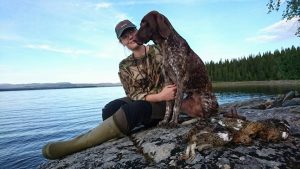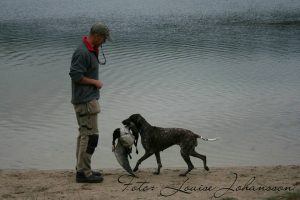We are Losing Legendary Methods (Waterwork)– by T. Mostert
Tok Mostert, a Professional Hunter from South Africa, now living in Sweden, is sharing his writings on dog training with us. You can start reading them from Part 1 here.
We are Losing Legendary Methods (Waterwork)– by T. Mostert
There are a few issues with water retrieves that you do not have with land retrieves. Some dogs enter water easily, others need a little encouragement and then some need a push. When to push will depend on where the dog is mentally, too soon and you may install a permanent fear of water in the dog. As stated before, the dog should enjoy training and you should make it a fun but structured experience. I want my dog steady and sitting by my side when I start him out, he should be as calm as possible. Arne always said it is a bad idea to cast and control the dog when you start, get a friend or your spouse, to do the casting. Make sure the dog can see the dummy or bird being cast and has a clear line of sight to the dummy or bird. The person making the cast should make bird or duck sounds before the cast to get the dog’s attention. The handler should focus on the dog only, make very sure the dog does not even lift during the cast, he should stay still.
Check that the dog follows the and cast, marks the dummy. Arne always started with a shallow cast, the dog would not need to swim more than 10 meters. This does not mean the dog only has to go 10 meters in the water, from the edge of the water the bottom should slope gently until the dog needs to swim the last 10 meters. If possible it works very well with a passage through reeds to get the dog straight out and straight in, always use the terrain to the dogs advantage to make the succeed. Arne taught me that once the dog is a meter away from the dummy, or bird, and it is clear that they will take it, give a quick yes, yes command, it works and I stick to it. Give the dog lots of encouragement on the way in to you, use the same bent at the knees method I described for land retrieves.
As the dog improves, increase the distance he has to swim, train in rivers with current and lakes where the dog cannot see the other side, expose the dog to multiple areas and entries.

Blind retrieves require a dog with skill and ability. It also requires a handler and a trainer that know what they are doing. The dog needs to have unwavering trust in what you are telling them to do, you cannot make a mistake, the dog will lose trust in you! There is no stop signal in water, the dog’s eyes cannot be on you all the time, so you better be sure when you give a verbal, whistle or physical command that the dog understands what you want. Do not start blind retrieves if you cannot get the dog to do the following, I say again do not start unless:
- Your dog is comfortable spending time in the water and is confident in the water.
2. Your dog can cross multiple types of surfaces under the water. Some areas will require a dog to wade from deep water to shallow water and back to deep water, mud and vegetation present problems for some dogs.
3. Your dog can take a straight line out into the water and keep it.
4. Your dog understands directional change commands and the out or back command.
5. Your dog understands the search command.
6. Your dog will not try and switch dummies or birds when there are multiple ones.
As Arne would tell me a hundred times, break it down. Entry,out, direction, search and delivery.
I have had judges stunned when Flake comes back with a completely dry bird, she is just comfortable in the water and does not panic when she has to stay out there. A few things to keep in mind.
Entrance into the water:
1. It is a careless dog that charges into the water, flying entries look great, but a dog that has never entered a body of water or is working virgin water and flies in is going to get hurt sometimes.
2. It is a careless owner that does not check the point of entry before he sends the dog out.
3. The dog should always, always take your line and go straight out. Do not let the dog look for another entry once you gave the out command. They lose the line and mark if they do, which makes it harder on them and you to adjust their new line to the old one.
Out:
1. Give the dog some indication that they are heading in the right direction.
2. Current will make the dog drift, keep it in mind.
Direction:
1. Your timing has to be perfect, especially if the dog has to go over an obstacle, cross a island and re-enter the water on the other side.
2. Remember the dog is not watching you, give the direction change command and once the dog looks back follow it up with a physical signal, you can even move your whole body in the direction you want the dog to go.
3. Use the wind, if you change direction with the bird lying upwind chances are greater for the dog to find it.
Search:
1. Once the dog is in or close to the reeds, grass, rocks etc where the bird is placed, I give the search command. Close to me is within 3-5 meters.
2. Give the dog time to locate the bird, resist the urge to direct the dog.
Delivery:
I do not want Flake to shake herself dry before delivery, neither do I want her to drop the bird.
Stand as close to the water edge as the judge would allow, Stay calm and positive, do not reach or grab for the bird, but be fast enough so the dog can shake itself dry if it wants to after delivery.

I have left out certain crucial bits of advice, like how to get a dog into the water, teaching it to swim and be calm and also the way to train a dog to take a straight entry on the blind retrieve.
It is simply because I believe you need a trainer to assist you here, so find a Legend and get going.
This concludes what I wish to share on retrieving. Before I start what is considered by many the Elite section of HPR’s I want to take a step back to obedience and discipline, because there is a correlation between obedience and field that needs to be clarified.

